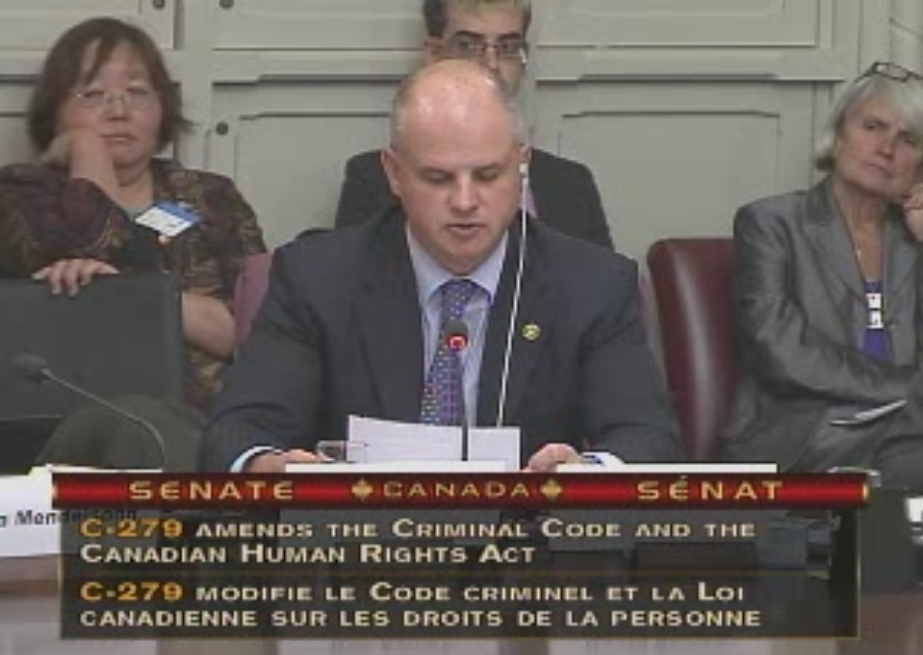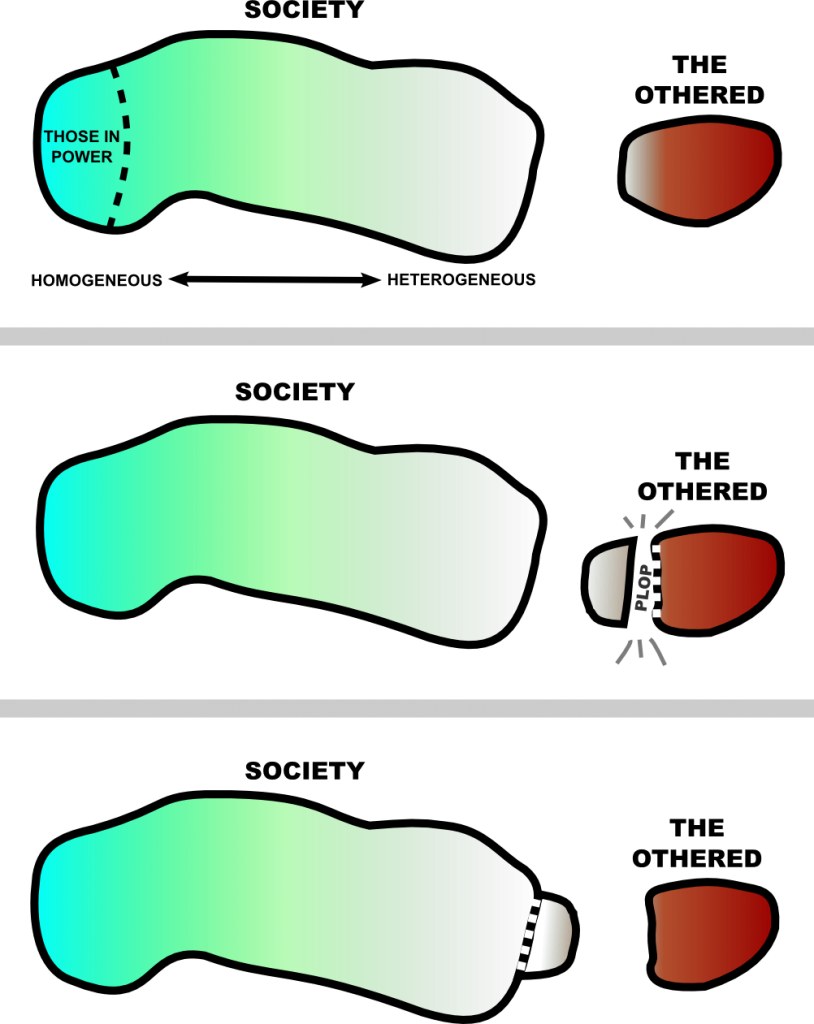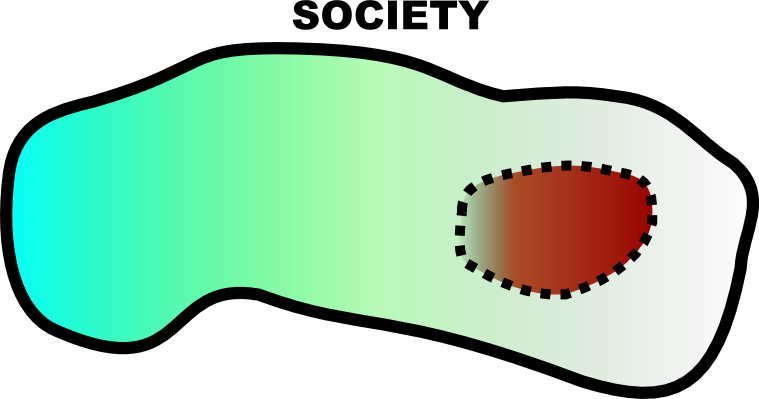Last Thursday, I attended the meeting for the Senate committee on Legal and Constitutional Affairs. On the agenda was Bill C-279, An Act to amend the Canadian Human Rights Act and the Criminal Code to add protections on the basis of gender identity. The plan was that I’d work from home from 5 AM until 9 AM, head over to the Parliament for the 10:30 AM meeting, and then return home at 1:30 PM to finish off the work day.

This was the second such meeting by the Senate, the first had taken place the week previous and I had watched the proceedings online. What was particularly striking for me in that first meeting is that none of the people involved in the discussions about trans people, including the witnesses, were trans. The bill’s terminology is “gender identity”, which I equate to transgender. Explicit protections for all other forms of gender variance, including genderqueer and non-binary identities, were removed at the behest of the Conservative party. That was the “gender expression” terminology.
I said that the lack of trans people was striking. What also stood out was how absolutely ignorant the two witnesses were on the very subject of the bill.
“We know that transgendered individuals, 95% of them are male…”
-Witness from the first meeting
For instance, one of them stated that 95% of trans people were “male”, by which they meant trans women. The absurdity of that figure would have been immediately evident to anyone a rudimentary knowledge of trans people. The misgendering was further indication that they’d never been acquainted with a trans person. It made me believe that their opinions weren’t rooted in expertise on these matters, but rather unsubstantiated fears.
Neither witness stood up for trans people, and the leading Conservative’s arguments in opposition of the bill were horrific. If we protect trans people, it was argued, then we’re protecting child molesters. This in a country where 26% of trans people are assaulted, where 40% attempt suicide due to a hostile environment, and where 74% of trans youth reported being harassed. The NDP sponsor of the bill made a great speech at the beginning and contested this bigotry but the mood was set.
“Apparently 0.3 percent of the people in our country are trans. Are we not infringing and trumping people’s rights by giving trans people the right to go into these areas?”
– Conservative senator during the first meeting
I decided I would show up for the next meeting, so that when these people spoke, they would at least see the faces of the people they’re equating with sexual predators. I would put on a skirt as they would otherwise believe me to be a cis male, undermining my purpose of being there.

I showed up on Parliament hill quite anxious. I wasn’t too sure of the protocol, if I had to have contacted the clerk before hand for some kind of clearance. Nope. Just literally walk up to the right building, sign in at the front desk, and make my way to the right room. I ran into people I recognized from Gender Mosaic and introduced myself.
I arrived and took my seat next to a woman. We talked a bit. She explained that she had been “transgendered” but later had changed her mind. She opposed the bill as it could mean that trans women might be able to use women’s shelters. Despite her own beliefs, I strongly question the veracity of her story. She believed stuff about trans people that would be among the first things to be dispelled if she had walked in their shoes for a day. The term she had for trans women was misgendering them, the awfulness of which would be understood if she had been trans or around trans people. It reminded me of how ex-gays talked. Nevertheless, we were both very kind to each other. I don’t think she caught on that I was trans despite the skirt. I tried to let her know that the reality was the reverse from what she believed – trans people are way more likely to be assaulted by cis people than the other way around.
This second meeting had six witnesses.
One of them was trans. He was a youth that had just won a case in Ontario through protections enshrined in the province. He relayed his story, which Maclean’s had covered in an article:
For Thompson, an avid hockey player now in Grade 12, the issue became acute about four or five years ago when he hit puberty.
“I’m just a boy. I’m just like any other kid out there growing up. I’m just a teenager,” he said.
“(But) once you get to a certain age, you are forced off into a different room, or basically a closet — sometimes they didn’t even have change rooms for girls.”
Thompson’s mother, Ailsa Thompson, said it was “very upsetting” when a coach booted her son from the boys dressing room on the basis that “she’s a girl.”
Other parents could also show a lack of understanding, she said.
“Parents would come in and kick Jesse out of the girls change room because it was for girls only.”
These attitudes made it very difficult for him to enjoy the sport that had been a significant part of him. The other witnesses were from EGALE, from the right-wing REAL Women of Canada, from the Canadian Civil Liberties Association, from the Ottawa Police Services, and a lawyer representing himself.
 If the mood of the last meeting was of opposition, this was of support. All the witnesses safe for the one from REAL Women of Canada were supportive of the protections suggested by the bill. The lawyer had been brought in by the conservatives, but he too turned out to favour the bill. The Ottawa Police Services, who are respected by the right-wing, were in support of the bill. Meanwhile, REAL Women of Canada made some pretty horrific statements – but it was actually not any worse than what the leading Conservative had already said. That undermined its effectiveness but it did not deter the Conservatives. To my surprise, they did not alter the arguments from the last meeting.
If the mood of the last meeting was of opposition, this was of support. All the witnesses safe for the one from REAL Women of Canada were supportive of the protections suggested by the bill. The lawyer had been brought in by the conservatives, but he too turned out to favour the bill. The Ottawa Police Services, who are respected by the right-wing, were in support of the bill. Meanwhile, REAL Women of Canada made some pretty horrific statements – but it was actually not any worse than what the leading Conservative had already said. That undermined its effectiveness but it did not deter the Conservatives. To my surprise, they did not alter the arguments from the last meeting.
They equated trans women with sexual predators. To validate this, they brought up three individual accounts of sexual assaults. The Conservatives were using the actions of perpetrators who might not have even been trans to portray an entire people as a potential threat and undeserving of protections. That was really ugly rhetoric to witness. At one point they argued that it was a matter of competing rights. It was an infringement of a cisgendered person’s rights if they were not allowed to deny people access to spaces on the mere merit that they might be trans. The targets of this vitriol was exclusively trans women under various monikers including “biological males” or “transgender males”. Trans men didn’t come up at all, perhaps because they were seen as women and therefore not a threat.
What the Conservatives managed to do is to drive the conversation away from the subjects of this bill, the many thousands of Canadians who are trans, and focus on horror stories that had nothing to do with their lives. But it had everything to do with the misconceptions and fears that cisgender people have of trans people. As astute politicians, they had to have known that their arguments were untrue. The most populous provinces in this country have similar legislation proving those fears unfounded. The Conservative’s interests were not in the wellbeing of the subject matter. They were not interested in even hearing from a trans person and bringing them on as a witness, they only brought on those opposed to their recognizing their existence such as REAL Women of Canada.
The answer appears to be that the bill is intended to be interpreted by the human rights tribunals and the courts in order to extend its reach to a number of other problematic sexual activities, including pedophilia. That is, the broad definition of the expression, “gender identity”, included in this bill, will eventually have to be interpreted by the appointed human rights tribunal and courts to determine the meaning of these words.
– REAL Women of Canada Brief on Bill C-279
There were breaks between pairs of witnesses. In them the supportive politicians and lobbying groups in attendance mingled. Amnesty International was there, passing their latest document on the matter. Gender Mosaic was consulting the politician who had sponsored the bill. I got to shake hands, which was neat. I kind of stood out as seemingly one of the few not representing an interest group.
As the day progressed, the Conservatives shifted tactics. The questions led on that they were looking to make an ammendment to the bill. Either by including protections on the basis of sex or by removing the definition of gender identity. The original bill had no definition but the Conservatives insisted one be put in in order to get the few votes they contributed for it to pass the House of Commons. If an ammendment were to go in the bill now, however, it would die. It would be sent back to the House of Commons and not be passed in time for the next election, killing it. This would be nothing new – the two previous incarnations of this legislation died in such a fashion. This had been going on since 2005. It was clear that the Conservatives would try to kill this bill through any means possible and this was a very clever way to go about it.
If I focus on the Conservatives, it’s because they’re the reason why this bill has yet to pass. Why any witnesses were there. Everyone else was in support. This spectacle was for them.
If this bill dies, so too will many people. That 40% suicide rate should be counted into the statistic of how many trans people are violently killed. Many of them would still be here if it wasn’t for this environment so hostile to their existence. Bills of this nature are no panacea but they are progress. For one it means that the federal government would no longer force trans people to undergo castration if they want their gender identity respected. It means that police services would start to track transphobic assaults. It also sends a message that helps facilitate a shift in attitudes.
As an aside, the woman beside me ended up playing another role in the proceedings. She had approached the Conservative senator the day before. During the proceedings he invoked the story of this ex-trans to legitimize his stance.
I came out of that meeting room with mixed feelings. Happy at the effective witnesses. Frustrated that EGALE had not selected an out non-cis person to represent them despite their candidate’s good performance and impressive qualifications. I felt that perhaps someone who was out and trans would have been more adept at bringing things back to the bigger picture. I was also impressed with Noa Mendelsohn Aviv from the Canadian Civil Liberties Association.
I ate lunch downtown, came back home, and went back to work.
 Totally worth it.
Totally worth it.





















